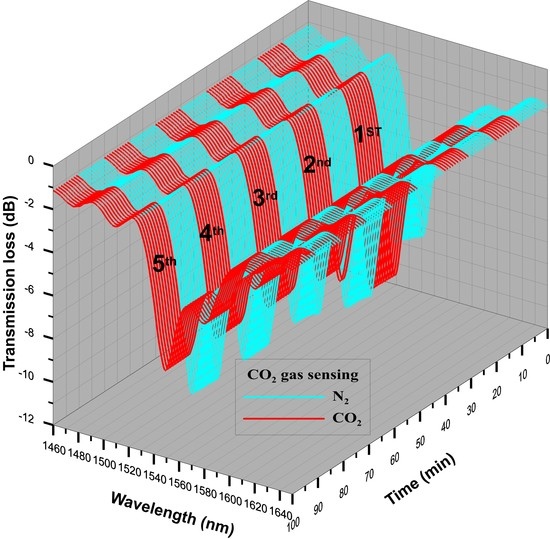A ZnO Nanoparticle-Coated Long Period Fiber Grating as a Carbon Dioxide Gas Sensor
Abstract
:1. Introduction
2. Working Principle of the CO2 Gas Sensor
3. Manufacturing Process and Experiment Setup
3.1. The ZnO-Coated LPFG Gas Sensor Manufacturing Process
3.2. CO2 Gas Sensor Experiment Setup
4. Results and Discussion
4.1. CO2 Gas Sensing Experiment Results
4.2. CO2 Gas Concentration Sensing Experiment
5. Conclusions
Acknowledgments
Author Contributions
Conflicts of Interest
References
- Qi, L.; Zhao, C.L.; Yuan, J.; Ye, M.; Wang, J.; Zhang, Z.; Jin, S. Highly reflective long period fiber grating sensor and its application in refractive index sensing. Sens. Actuator B Chem. 2014, 193, 185–189. [Google Scholar] [CrossRef]
- Zou, F.; Liu, Y.; Deng, C.; Dong, Y.; Zhu, S.; Wang, T. Refractive index sensitivity of nano-film coated long-period fiber gratings. Opt. Express 2015, 23, 1114–1124. [Google Scholar] [CrossRef] [PubMed]
- Yoon, M.S.; Kim, H.J.; Kim, S.J.; Han, Y.G. Influence of the waist diameters on transmission characteristics and strain sensitivity of microtapered long-period fiber gratings. Opt. Lett. 2013, 38, 2669–2672. [Google Scholar] [CrossRef] [PubMed]
- Wang, P.; Xian, L.; Li, H. Fabrication of phase-shifted long-period fiber grating and its application to strain measurement. IEEE Photon. Technol. Lett. 2015, 27, 557–560. [Google Scholar] [CrossRef]
- Bai, Z.; Zhang, W.; Gao, S.; Zhang, H.; Wang, L.; Liu, F. Bend-insensitive long period fiber grating-based high temperature sensor. Opt. Fiber Technol. 2015, 21, 110–114. [Google Scholar] [CrossRef]
- Zou, F.; Liu, Y.; Zhu, S.; Deng, C.; Dong, Y.; Wang, T. Temperature Sensitivity Enhancement of the Nano-Film Coated Long-Period Fiber Gratings. IEEE Sens. J. 2016, 16, 2460–2465. [Google Scholar] [CrossRef]
- Renganathan, B.; Sastikumar, D.; Gobi, G.; Yogamalar, N.R.; Bose, A.C. Nanocrystalline ZnO coated fiber optic sensor for ammonia gas detection. Opt. Laser Technol. 2011, 43, 1398–1404. [Google Scholar] [CrossRef]
- Coelho, L.; Viegas, D.; Santos, J.L.; de Almeida, J.M.M.M. Characterization of zinc oxide coated optical fiber long period gratings with improved refractive index sensing properties. Sens. Actuator B Chem. 2016, 223, 45–51. [Google Scholar] [CrossRef]
- Dikovska, A.O.; Atanasov, P.A.; Andreev, A.T.; Zafirova, B.S.; Karakoleva, E.I.; Stoyanchov, T.R. ZnO thin film on side polished optical fiber for gas sensing applications. Appl. Surf. Sci. 2007, 254, 1087–1090. [Google Scholar] [CrossRef]
- Coelho, L.; Viegas, D.; Santos, J.L.; de Almeida, J.M.M.M. Zinc oxide coated optical fiber long period gratings for sensing of volatile organic compounds. In Proceedings of the SPIE Photonics Europe, International Society for Optics and Photonics, Brussels, Belgium, 3–7 April 2016.
- Chang, S.P.; Wen, C.H.; Chang, S.J. Two-dimensional ZnO nanowalls for gas sensor and photoelectrochemical applications. Electron. Mater. Lett. 2014, 10, 693–697. [Google Scholar] [CrossRef]
- Segawa, H.; Ohnishi, E.; Arai, Y.; Yoshida, K. Sensitivity of fiber-optic carbon dioxide sensors utilizing indicator dye. Sens. Actuator B Chem. 2003, 94, 276–281. [Google Scholar] [CrossRef]
- Samarasekara, P.; Yapa, N.; Kumara, N.; Perera, M. CO2 gas sensitivity of sputtered zinc oxide thin films. Bull. Mater. Sci. 2007, 30, 113–116. [Google Scholar] [CrossRef]
- Chu, C.S.; Lo, Y.L. Fiber-optic carbon dioxide sensor based on fluorinated xerogels doped with HPTS. Sens. Actuator B Chem. 2008, 129, 120–125. [Google Scholar] [CrossRef]
- Chu, C.S.; Lo, Y.L. Highly sensitive and linear optical fiber carbon dioxide sensor based on sol-gel matrix doped with silica particles and HPTS. Sens. Actuator B Chem. 2009, 143, 205–210. [Google Scholar] [CrossRef]
- Konstantaki, M.; Klini, A.; Anglos, D.; Pissadakis, S. An ethanol vapor detection probe based on a ZnO nanorod coated optical fiber long period grating. Opt. Express 2012, 20, 8472–8484. [Google Scholar] [CrossRef] [PubMed]
- Lin, C.Y.; Wang, L.A.; Chern, G. Corrugated long-period fiber gratings as strain, torsion, and bending sensors. J. Lightw. Technol. 2001, 19, 1159–1168. [Google Scholar]







© 2016 by the authors; licensee MDPI, Basel, Switzerland. This article is an open access article distributed under the terms and conditions of the Creative Commons Attribution (CC-BY) license (http://creativecommons.org/licenses/by/4.0/).
Share and Cite
Wu, C.-W.; Wu, C.-C.; Chiang, C.-C. A ZnO Nanoparticle-Coated Long Period Fiber Grating as a Carbon Dioxide Gas Sensor. Inventions 2016, 1, 21. https://doi.org/10.3390/inventions1040021
Wu C-W, Wu C-C, Chiang C-C. A ZnO Nanoparticle-Coated Long Period Fiber Grating as a Carbon Dioxide Gas Sensor. Inventions. 2016; 1(4):21. https://doi.org/10.3390/inventions1040021
Chicago/Turabian StyleWu, Chao-Wei, Chien-Chung Wu, and Chia-Chin Chiang. 2016. "A ZnO Nanoparticle-Coated Long Period Fiber Grating as a Carbon Dioxide Gas Sensor" Inventions 1, no. 4: 21. https://doi.org/10.3390/inventions1040021
APA StyleWu, C.-W., Wu, C.-C., & Chiang, C.-C. (2016). A ZnO Nanoparticle-Coated Long Period Fiber Grating as a Carbon Dioxide Gas Sensor. Inventions, 1(4), 21. https://doi.org/10.3390/inventions1040021






